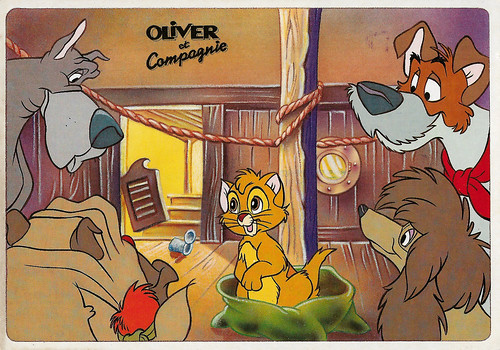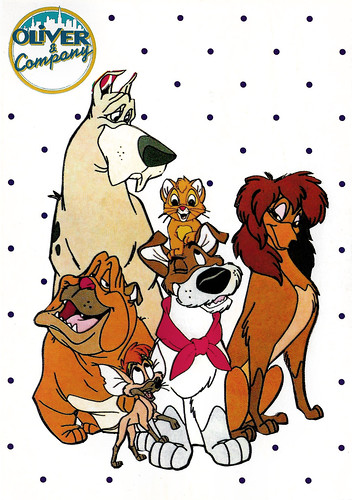
French postcard by MB, Paris, no. D 640, 5/3. Image: Disney. Publicity still for Oliver & Company (1988).

French postcard by MB, Paris, no. D 640, 5/4. Image: Disney. Publicity still for Oliver & Co. (1988).

French postcard by MB, Paris, no. D 640, 5/5. Image: Disney. Publicity still for Oliver & Co. (1988).
Oliver Twist with dogs
After the release of The Black Cauldron (Ted Berman, Richard Rich, 1985), Disney's Michael Eisner and Jeffrey Katzenberg invited the animators to pitch potential ideas for upcoming animated features.
After John Musker and Ron Clements suggested "The Little Mermaid" and "Treasure Island in Space", animator Pete Young suggested, "Oliver Twist with dogs".
Originally wanting to produce a live-action adaptation of the musical 'Oliver!' at Paramount Pictures, Katzenberg approved of the pitch. The working title of the film during production was 'Oliver and the Dodger'. It pre-dated the Disney Renaissance.
The original central brain trust of Disney animators, the 'Nine Old Men', had retired in the early 1980s, which signaled the entrance for the next generation of Disney animators, including the film's supervising animators Glen Keane, Ruben A. Aquino, Mike Gabriel, Hendel Butoy, and Mark Henn.
At a certain point, it was to be a sequel to The Rescuers (John Lounsbery, Wolfgang Reitherman, Art Stevens, 1977). If this had happened, it would have given the character of Penny more development, showing her living her new life in New York City with Georgette, as well as her new adoptive parents.
This idea was eventually scrapped because the producers had then felt that the story would not have been convincing. Young was originally assigned to co-direct the film with George Scribner, a Disney newcomer who had recently joined from the Hanna-Barbera studio but suddenly died in mid-October 1985.
Richard Rich, who had previously co-directed The Fox and the Hound (Ted Berman, Richard Rich, Art Stevens, 1981) and The Black Cauldron (Ted Berman, Richard Rich, 1985), was then brought on-board to replace Young, but due to acting belligerent towards the president of Walt Disney Feature Animation, Peter Schneider, as what Schneider claimed, he was fired in 1986. Rich was not replaced after his firing, leaving Scribner as the sole director.

Italian postcard by Grafiche Biondetti S.R.L., Verona, no. 148/2. Image: Disney. Publicity still for Oliver & Company (George Scribner, 1988).

Italian postcard by Grafiche Biondetti S.R.L., Verona, no. 148/3. Image: Disney. Publicity still for Oliver & Company (George Scribner, 1988).

Italian postcard by Grafiche Biondetti S.R.L., Verona, no. 148/4. Image: Disney. Publicity still for Oliver & Company (George Scribner, 1988).
The first Disney film to extensively feature computer animation
Oliver & Company (1988) was the first Disney film to extensively feature computer animation. The two immediately preceding Disney films, The Black Cauldron (Ted Berman, Richard Rich, 1985) and The Great Mouse Detective (Ron Clements, Burny Mattinson, David Michener, John Musker, 1986), only featured it during special sequences. The CGI effects were used for making the skyscrapers, the cars, trains, Fagin's scooter, and the climactic subway chase.
It was also the first Disney film to have a department created specifically for computer animation. The film was a test run one before The Walt Disney Company would fully commit to returning to a musical format for their animated films. It was the first such film to be a musical since The Fox and the Hound (Ted Berman, Richard Rich, Art Stevens, 1981). For the next decade, all of Walt Disney Feature Animation's films, starting with The Little Mermaid (Ron Clements, John Musker, 1989), were also musicals, except for The Rescuers Down Under (Hendel Butoy, Mike Gabriel, 1990).
Oliver & Company (1988) was one of the first animated Disney films to introduce new sound effects for regular use, as replacements for many of the classic sounds originally in the Disney library, which would be used occasionally in later Disney films. However, The Little Mermaid (Ron Clements, John Musker, 1989) became the basis for the introduction of even more new sound effects.
The new sound effects were first introduced with The Black Cauldron (Ted Berman, Richard Rich, 1985), while The Great Mouse Detective (Ron Clements, Burny Mattinson, David Michener, John Musker, 1986), released a year after the previous film, featuring the classic Disney sound effects, including the then fifty-year-old Castle Thunder and the classic Goofy holler. However, the Disney television animation studio continued extensively using the classic Disney sound effects for several years, while the feature animation studio retired the original sound effects.
Certain animal characters from previous Disney films make cameo characters in the film. Four of the dogs shown are Peg, Jock, and Trusty from Lady and the Tramp (Clyde Geronimi, Wilfred Jackson, Hamilton Luske, 1955), and Pongo from One Hundred and One Dalmatians (Clyde Geronimi, Hamilton Luske, Wolfgang Reitherman, 1961).
Opening on the same weekend as Don Bluth's The Land Before Time (1988), which debuted at number one in the United States and Canada grossing $7.5 million, Oliver & Company opened at fourth, grossing $4 million. Nevertheless, Oliver & Company out-grossed The Land Before Time with a total gross in the United States and Canada of $53 million compared to the latter's $46 million, making it the animated film with the highest gross from its initial run.
Oliver & Company was also the first animated film to gross $100 million worldwide in its initial release. Its success prompted Disney's Senior Vice President of Animation, Peter Schneider, to announce the company's plans to release animated features annually.

Italian postcard by Grafiche Biondetti S.R.L., Verona, no. 148/5. Image: Disney. Publicity still for Oliver & Company (George Scribner, 1988).

Italian postcard by Grafiche Biondetti S.R.L., Verona, no. 148/7. Image: Disney. Publicity still for Oliver & Company (George Scribner, 1988).

Italian postcard by Grafiche Biondetti S.R.L., Verona, no. 148/8. Image: Disney. Publicity still for Oliver & Company (George Scribner, 1988).
Sources: Disney Wiki, Wikipedia, and IMDb.
No comments:
Post a Comment